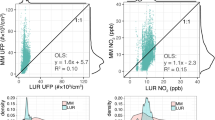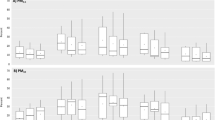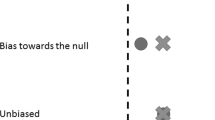Abstract
In large epidemiological studies, many researchers use surrogates of air pollution exposure such as geographic information system (GIS)-based characterizations of traffic or simple housing characteristics. It is important to evaluate quantitatively these surrogates against measured pollutant concentrations to determine how their use affects the interpretation of epidemiological study results. In this study, we quantified the implications of using exposure models derived from validation studies, and other alternative surrogate models with varying amounts of measurement error on epidemiological study findings. We compared previously developed multiple regression models characterizing residential indoor nitrogen dioxide (NO2), fine particulate matter (PM2.5), and elemental carbon (EC) concentrations to models with less explanatory power that may be applied in the absence of validation studies. We constructed a hypothetical epidemiological study, under a range of odds ratios, and determined the bias and uncertainty caused by the use of various exposure models predicting residential indoor exposure levels. Our simulations illustrated that exposure models with fairly modest R2 (0.3 to 0.4 for the previously developed multiple regression models for PM2.5 and NO2) yielded substantial improvements in epidemiological study performance, relative to the application of regression models created in the absence of validation studies or poorer-performing validation study models (e.g., EC). In many studies, models based on validation data may not be possible, so it may be necessary to use a surrogate model with more measurement error. This analysis provides a technique to quantify the implications of applying various exposure models with different degrees of measurement error in epidemiological research.
This is a preview of subscription content, access via your institution
Access options
Subscribe to this journal
Receive 6 print issues and online access
$259.00 per year
only $43.17 per issue
Buy this article
- Purchase on Springer Link
- Instant access to full article PDF
Prices may be subject to local taxes which are calculated during checkout




Similar content being viewed by others
References
Baxter L.K., Clougherty J.E., Paciorek C.J., Wright R.J., and Levy J.I. Predicting residential indoor concentrations of nitrogen dioxide, fine particulate matter, and elemental carbon using questionnaire and geographic information system based data. Atmos Environ 2007: 41 (31): 6561–6571.
Belanger K., Beckett W.S., Triche E., Bracken M.B., Holford T.R., Ren P., McSharry J.E., Gold D.R., Platts-Mills T.A.E., and Leaderer B.P. Symptoms of wheeze and persistent cough if the first year of life: associations with indoor allergens, air contaminants, and maternal history of asthma. Am J Epidemiol 2003: 158 (3): 195–202.
Brauer M., Hoek G., Van Vliet P., Meliefste K., Fischer P.H., Wijga A., Koopman L.P., Neijens H.J., Gerritsen J., Kerkho M., Heinrich J., Bellander T., and Brunekreef B. Air pollution from traffic and the development of respiratory infections and asthmatic and allergic symptoms in children. Am J Respir Crit Care Med 2002: 166 (8): 1092–1098.
Brenner H. Correcting for exposure misclassification using an alloyed gold standard. Epidemiology 1996: 7 (4): 406–410.
Carroll R., Rupert D., and Stefanski L. Measurement Error in Nonlinear Models, 1st edn. Chapman & Hall: London, 1995.
Freedman L.S., Midthune D., Carroll R.J., and Kipnis V. A comparison of regression calibration, moment reconstruction and imputation for adjusting for covariate measurement error in regression. Stat Med 2008: 27 (25): 5195–5216.
Garrett M.H., Hooper M.A., Hooper B.M., and Abramson M.J. Respiratory symptoms in children and indoor exposure to nitrogen dioxide and gas stoves. Am J Respir Crit Care Med 1998: 158: 891–895.
Garshick E., Laden F., Hart J.E., and Caron A. Residence near a major road and respiratory symptoms in US. veterans. Epidemiology 2003: 14 (6): 728–736.
Gauderman W.J., Avol E., Lurmann F., Kuenzli N., Gilliland F., Peters J., and McConnell R. Childhood asthma and exposure to traffic and nitrogen dioxide. Epidemiology 2005: 16 (6): 737–743.
Heinrich J., Topp R., Gehring U., and Thefeld W. Traffic at residential address, respiratory health, and atopy in adults: the National German Health Study. Environ Res 2005: 98 (2): 240–249.
Jarvis D., and Chinn S. Association of respiratory symptoms and lung function in young adults with the use of domestic gas appliances. Lancet 1996: 347 (8999): 426–432.
Jerrett M., Arain A., Kanaroglou P., Beckerman B., Potoglou D., Sahsuvaroglu T., Morrison J., and Giovis C. A review and evaluation of intraurban air pollution exposure models. J Expo Anal Environ Epidemiol 2005: 15 (2): 185–204.
Marbury M.C., Maldonado G., and Waller L. The indoor air and children's health study: methods and incidence rates. Epidemiology 1996: 7 (2): 166–174.
Nakai S., Nitta H., and Maeda K. Respiratory health associated with exposure to automobile exhaust II Personal NO2 exposure levels according to distance from the roadside. J Expo Anal Environ Epidemiol 1995: 5 (2): 125–136.
Rjinders E., Janssen N.A.H., van Vilet P.H.N., and Brunekreef B. Personal and outdoor nitrogen dioxide concentrations in relation to degree of urbanization and traffic density. Environ Health Perspect 2001: 109 (Suppl 3): 411–417.
Roorda-Knape M.C., Janssen N.A.H., de Hartog J.J., Van Vliet P.H.N., Harssema H., and Brunkreef B. Air pollution from traffic in city districts near major motorways. Atmos Environ 1998: 32 (11): 1921–1930.
Ryan P., LeMasters G., Biagini J., Bernstein D., Grinshpun S.A., Shukla R., Wilson K., Villareal M., Burkle J., and Lockey J. Is it traffic type, volume, or distance? Wheezing in infants living near truck and bus traffic. J Allergy Clin Immunol 2005: 116 (2): 279–284.
Spiegelman D., Schneeweiss S., and McDermott A. Measurement error correction for logistic regression models with an “alloyed gold standard”. Am J Epidemiol 1997: 145 (2): 184–196.
Vaeth M., and Skovlund E. A simple approach to power and sample size calculations in logistic regression and Cox regression models. Stat Med 2004: 23 (11): 1781–1792.
Wacholder S., Armstrong B., and Hartge P. Validation studies using an alloyed gold standard. Am J Epidemiol 1993: 137 (11): 1251–1258.
Acknowledgements
The author and research were supported by the Health Effects Institute (HEI 4727-RFA04-5/05-1), the National Institutes of Health (NIH U01 HL072494, NIH R03 ES013988), and the National Institute of Occupational Safety and Health (PHS 5 T42 CCT122961-02). We gratefully acknowledge the hospitality of the ACCESS participants, Dr. Jane Clougherty, and Steven Melly from the Department of Environmental Health at Harvard School of Public Health.
Author information
Authors and Affiliations
Corresponding author
Additional information
Disclaimer
The United States Environmental Protection Agency through its Office of Research and Development partially funded the research described here. It has been subjected to Agency review and approved for publication.
Conflict of interest
The authors state no conflict of interest.
Supplementary Information accompanies the paper on the Journal of Exposure Science and Environmental Epidemiology website (http://www.nature.com/jes)
Rights and permissions
About this article
Cite this article
Baxter, L., Wright, R., Paciorek, C. et al. Effects of exposure measurement error in the analysis of health effects from traffic-related air pollution. J Expo Sci Environ Epidemiol 20, 101–111 (2010). https://doi.org/10.1038/jes.2009.5
Received:
Accepted:
Published:
Issue Date:
DOI: https://doi.org/10.1038/jes.2009.5
Keywords
This article is cited by
-
Prenatal environmental exposures and associations with teen births
Journal of Exposure Science & Environmental Epidemiology (2021)
-
A framework for estimating the US mortality burden of fine particulate matter exposure attributable to indoor and outdoor microenvironments
Journal of Exposure Science & Environmental Epidemiology (2020)
-
Cyclists’ exposure to air pollution: in situ evaluation with a cargo bike platform
Environmental Monitoring and Assessment (2020)
-
Community-level spatial heterogeneity of chemical constituent levels of fine particulates and implications for epidemiological research
Journal of Exposure Science & Environmental Epidemiology (2011)
-
A study protocol to evaluate the relationship between outdoor air pollution and pregnancy outcomes
BMC Public Health (2010)



